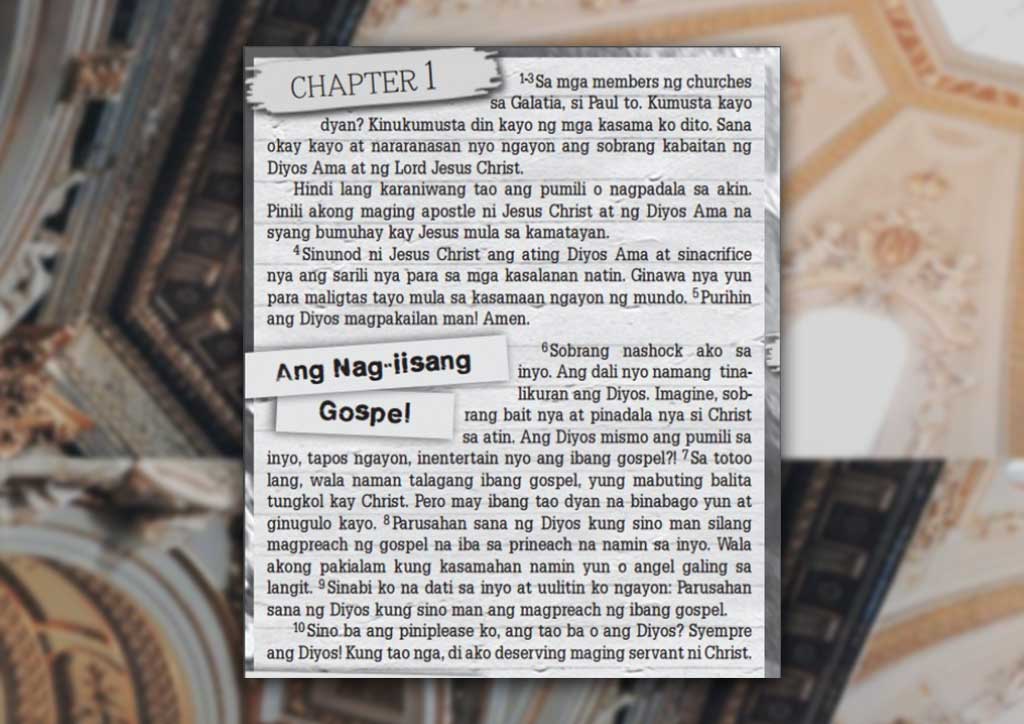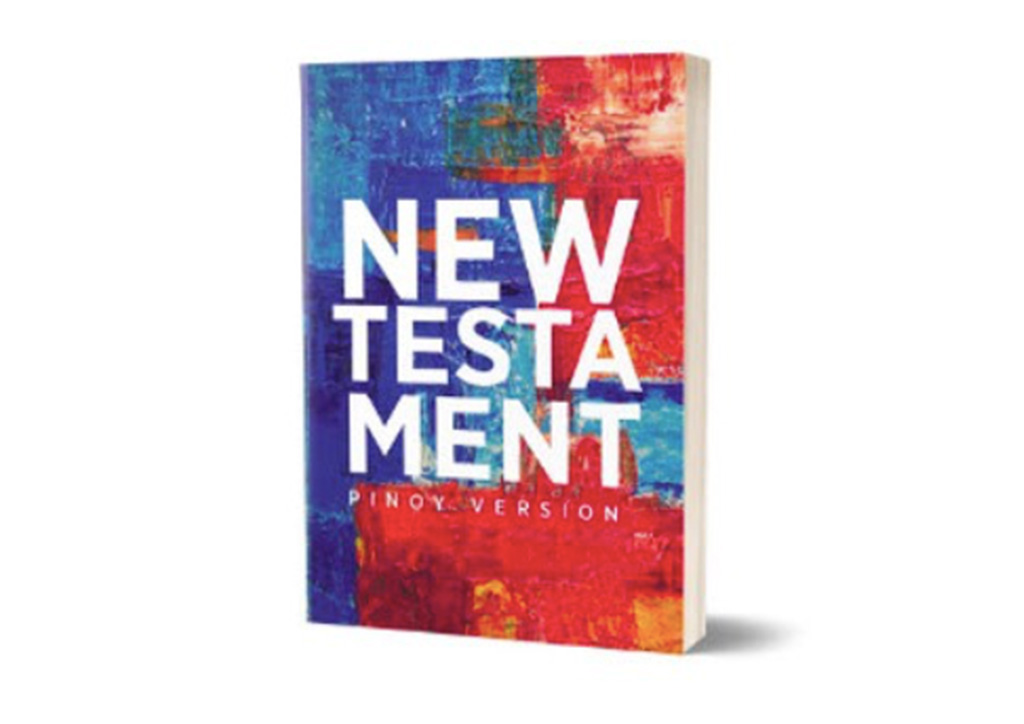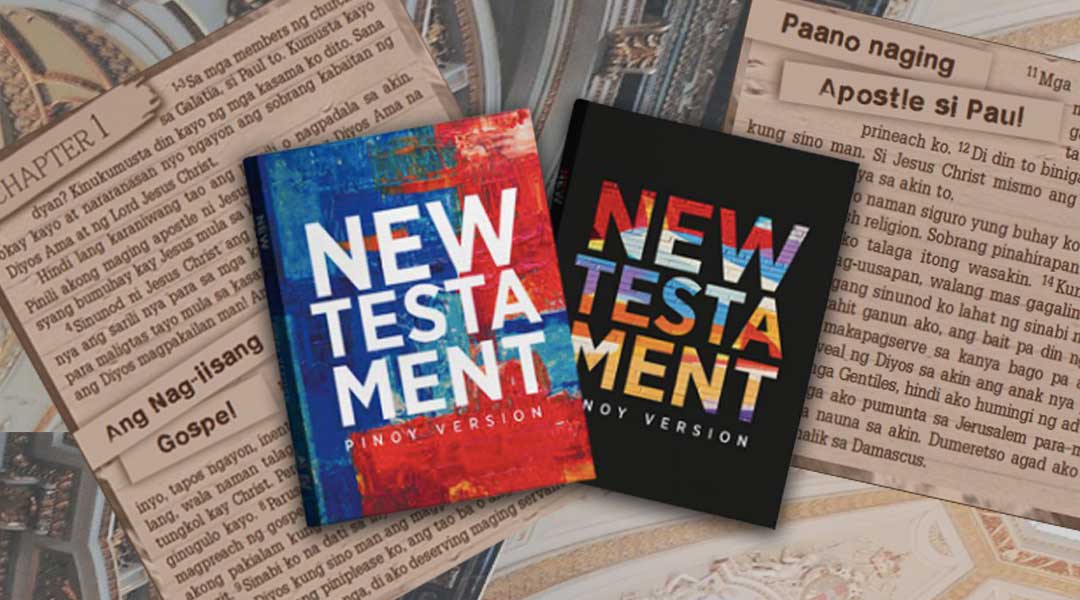Where the perceived rigors and requisites of religion dominate the context of Catholicism, there now exists a Taglish translated bible that makes it easier to grasp and live out. The question is: Is it a boon or blasphemy?
Related: 5 Books That Will Help You Get Through Your 20s
When I read on a website that there was a new Taglish version of the New Testament, I was immediately curious. The accompanying photo displayed it as a simple paperback with colorful block text, which was a little different from the nondescript, stark devoutness of your typical Bible. But aside from the photo of the book, there was one selected quote from the Gospel of Mark, recounting a part of when the Roman Soldiers whipped and scourged Jesus hours before crucifying him: “Tapos, pinagtripan nila si Jesus. Sinaluduhan nila s’ya at sinabi, ‘Mabuhay ang hari ng mga Jews!’ Hinampas nila ng stick ang ulo ni Jesus at dinuraan siya.” (Mark 15:18)”
Jesus’ suffering is one that most Filipinos know well, as we learned it from our Christian Living classes growing up or heard it being proclaimed by the priest when we go to Holy Mass. But we’ve probably never heard the Passion of Christ referred to as Jesus “na napagtripan”—at least within the confines of the Liturgy of the Word.

Whether you think it’s hospitality or colonial mentality, Filipinos tend to bend over backwards to accommodate others, especially foreigners. Taglish is the perfect example of that. We’ve transformed and transfigured Filipino to accommodate English so much that we can already conjugate the heck out of any English word in Filipino (“Nag-bake ako ng bread; triny mo ba?”). Who can blame us? Our native tongue is Filipino, but we were given Western-style education and exposed to a myriad of American brands and media everyday. Not only are both languages part of our history, but of our daily lives today as well.
This isn’t necessarily a bad thing. Language has never been static, and we see it grow and change. Familiar words take on new meanings: hustle, which originally meant a scam, now often refers to a side job or someone’s efforts. Retronyms, which are newer names for an existing thing that differentiates the original form/version from a more recent one (like cloth diaper or landline phone), emerge all the time. New words and terms are added to dictionaries, while older, antiquated words are quietly being removed. And yes, formal language melts into colloquial vernacular.
That’s why the idea of a Taglish New Testament makes so much sense to me. I’m a Catholic and I go to mass every Sunday, but as much as I can, I avoid the Filipino masses. While I completely speak and understand Filipino, going to mass in Filipino feels like attending your meetings as everyone speaks in medieval language, like each person is a character in Geoffrey Chaucer’s The Canterbury Tales. The language is heartfelt, I’m sure, but it’s also overly traditional. I mean, who says “Kaawan mo kami” when we ask for mercy? We’d probably say, “Sorry” first, or if we really want to translate it directly—“Maawa ka.”

Many netizens expressed their concern and outrage at this informal translation, declaring it as irreverent and disrespectful. Some said the assumption that today’s generation was unable to understand or comprehend the traditional text was insulting and condescending. Wanting to make my own judgement, I ordered a copy and dove straight in. I saw that it was actually still written in 95% Filipino, with a little bit of English peppered in. It wasn’t trying to be overly cool or casual with vulgar slang or lingo; neither was it annoyingly and awkwardly pieced together in bad conyo girl English. It all read, in all honesty, very naturally. Passages sounded like someone from this generation was sharing stories about Jesus. One of my favorite part of the translation is how they kept English phrases we use, like how Jesus greets his disciples “Peace be with you.” The original Tagalog Bible translates this to “Kapayapaa’y suma inyo,” and honestly: who talks like that in real life? From the Gospels to the letters of St. Paul, everything was easy to read and understand.
With a little bit of research, I found that this version was released in 2018 and is, in fact, an official translation, commissioned by the ecumenical Philippine Bible Society. (Perhaps with so much time on our hands and magnified by the lens of the internet and the roar of the mob on social media, a good chunk of us got wind of it only now.) Six translators from different faiths (Catholic, Baptist, Methodist, and Evangelical) worked on the Greek text of the New Testament, and their approach was meaning-based instead of literal to honor its origins and keep the context of the Scriptures. Most importantly, as one of the translation consultants who worked on the project said, they had no intentions of disregarding God as the Divine Author of the Bible. This, obviously, was not some project for publicity or attention, nor was it a move to replace the original texts. It is a legitimate effort to bring the traditional texts closer to the people, in a language they are comfortable with.
The Catholic Church is not an easy sell these days. Many are turned off by the rigidity and all the seemingly trite pomp in traditions and teachings, which people feel they cannot connect with. Listening to the readings at Mass or reading the Bible, for example, seems like a boring and meaningless chore that you just do because a priest or your Catholic studies teacher told you so. But in fact, the Word of God can be a source of guidance, light and love for the faithful. And for that to happen, the first requirement is that it is understandable and comprehendible. We have to recall that before the 1960s, masses were only said in Latin, but after the Second Vatican Council, Churches were allowed to celebrate mass in local vernacular. While many had originally rallied to keep the sanctity of the original Latin Mass, the Church realized there was so much more benefits to having the community connect with the liturgy through a mass they can participate in, in their native tongue.

Scripture is scripture, of course, but what is wrong with having a version of the Bible that helps us touch more people, especially if it retains the meaning? At some point, we have all read comic versions of Greek myths, binged on TV adaptions of Victorian novels, and watched movies based on Shakespeare’s works, and while we usually defer to the belief that canon is best, all of these other versions—made or written in languages or forms that may be viewed as informal or casual—often become an opportunity for more people to be more interested and invested in (and actually understand!) the original. Why should we sneer at hip hop when it’s used in telling the story of one of America’s founding fathers, or berate kids from reading comics of Noli Me Tangere (which, was my first exposure to Rizal’s works)?
Language is important because it’s the vehicle of relationships, and whether it’s religion or politics or even romance, there can be no connection without communication. If we truly want to create dialogue, we have to use language appropriate for the situation, the intent, and the audience. Connecting with the same vernacular results to more than just exchanging the same words, but the recognition and respect of people’s beliefs, culture, and history. In the same way that we are recognizing the importance of representation in media, we have to realize the power in hearing and reading the doctrines that form the foundation of your faith in a language that you understand and actually use.
We have to realize and accept that in many cases today, formal Filipino may not be the language we use as madlang people (as the good people in It’s Showtime have named us), and at the end of the day, the language of the Scriptures and the streets have to meet somewhere to continue guiding, sustaining, and encouraging faith. It will be different for many people, but having the opportunity to find what resonates with you—whether it’s English, Filipino, Taglish, or even original Greek text—can be a game- and life-changer in your personal journey.










